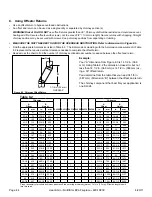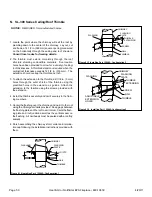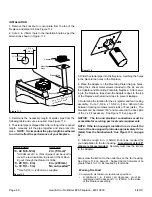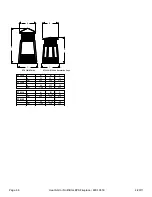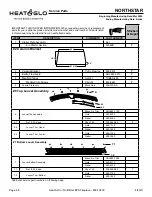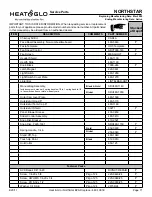
Page 56
4/20/11
Heat & Glo • NorthStar EPA Fireplace • 480-1081E
Position and secure the hearth extension over the protective
metal strips that have been placed partially under the fireplace
front. These strips should be protruding approximately 2 in. (51
mm) from under the fireplace front and 2 in. (51 mm) on both
sides of the fireplace opening. See Figure 10.7.
Seal the crack between the hearth extension and fireplace with
a bead of non-combustible sealant.
See Figure 10.8. Apply a
non-combustible finishing material of your choice to the hearth
extension.
NOTICE:
see pages 36-37 and 55 “clearances to combus-
tibles, hearth extensions / floor protection” for clearances
required for different hearth extension installations. The
clearances must be strictly adhered to.
Warning! Fire Risk!
Hearth extensions are to be installed only as illustrated
to prevent high tempertures from occurring on concealed
combustible materials.
Hearth sealing strips prevent burning or hot particles from
inadvertently falling directly on combustible surfaces in the
event the building should settle and disturb the original
construction.
Figure 10.7 Positioning the Protective Metal Hearth Strips
Seal with
non-combustible
sealant
Figure 10.8 Position the Hearth Extension
Protective metal strips are placed 2 in.(51mm) under the front of the
fireplace and must extend beyond the front and sides of fireplace
opening by 2 in. (51mm). Nail or screw metal strips in place.
Pallet
Mounting
Brackets
1 in. (25mm) Overlap
E. Finishing Material
WARNING
!
Do not install combustible materials over the
metal fireplace face of the fireplace! This poses a safety
hazard and may start a fire.
You may only use noncombustible material over the metal
face of the fireplace.
NOTICE: The decorative fascia must be removable for future
serviceability of the Automatic Combustion Control.
• Combustible Material
Materials made of or surfaced with wood, compressed
paper, plant fibers, plastics, or other materials that can
ignite and burn, whether flame proofed or not, or whether
plastered or un-plastered shall be considered combus-
tible materials.
• Non-Combustible Material
Materials which will not ignite and burn. Such materials
are those consisting entirely of steel, iron, brick, tile, con-
crete, slate, glass or plasters, or any combination thereof.
Materials that are reported as passing ASTM E 136,
Standard Test Method for Behavior of Materials, in a Ver-
tical Tube Furnace at 750°C, shall be considered non-
combustible materials.
D. Position the Hearth Extension



